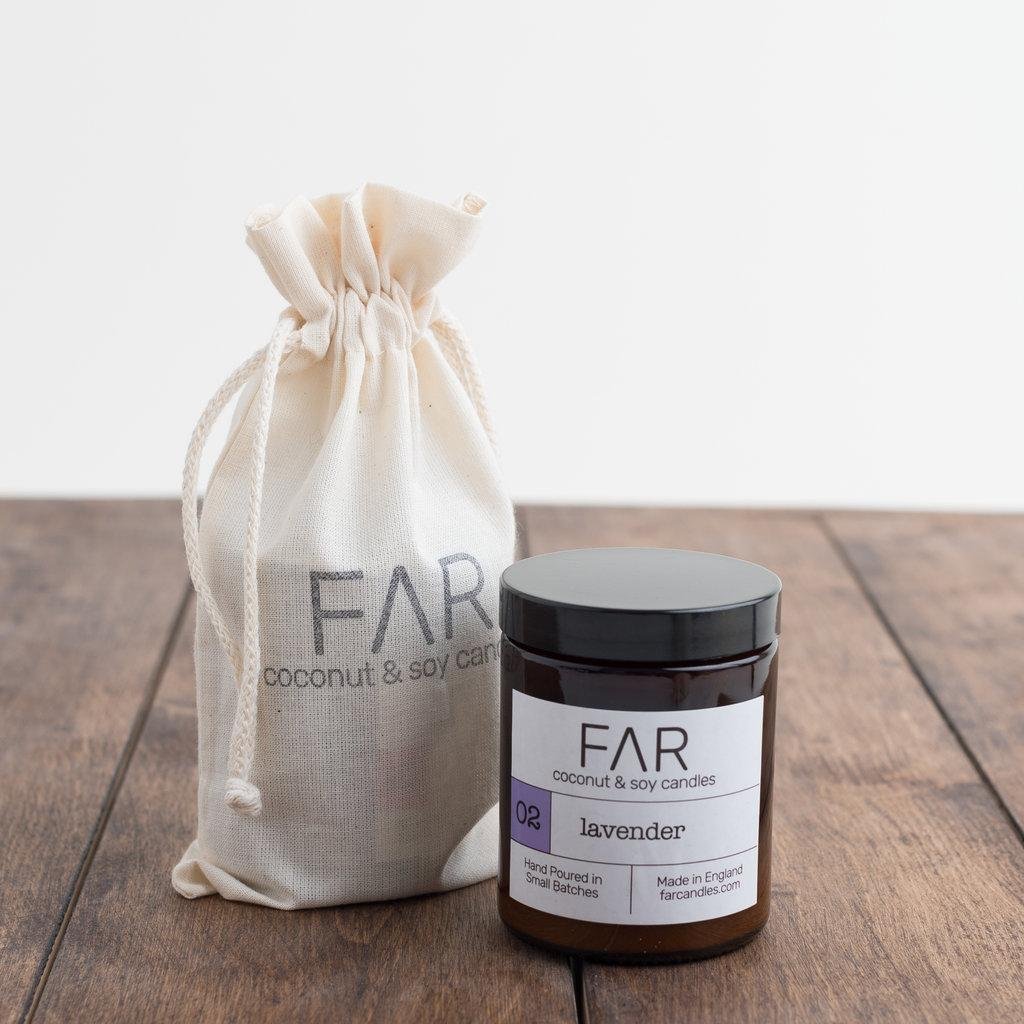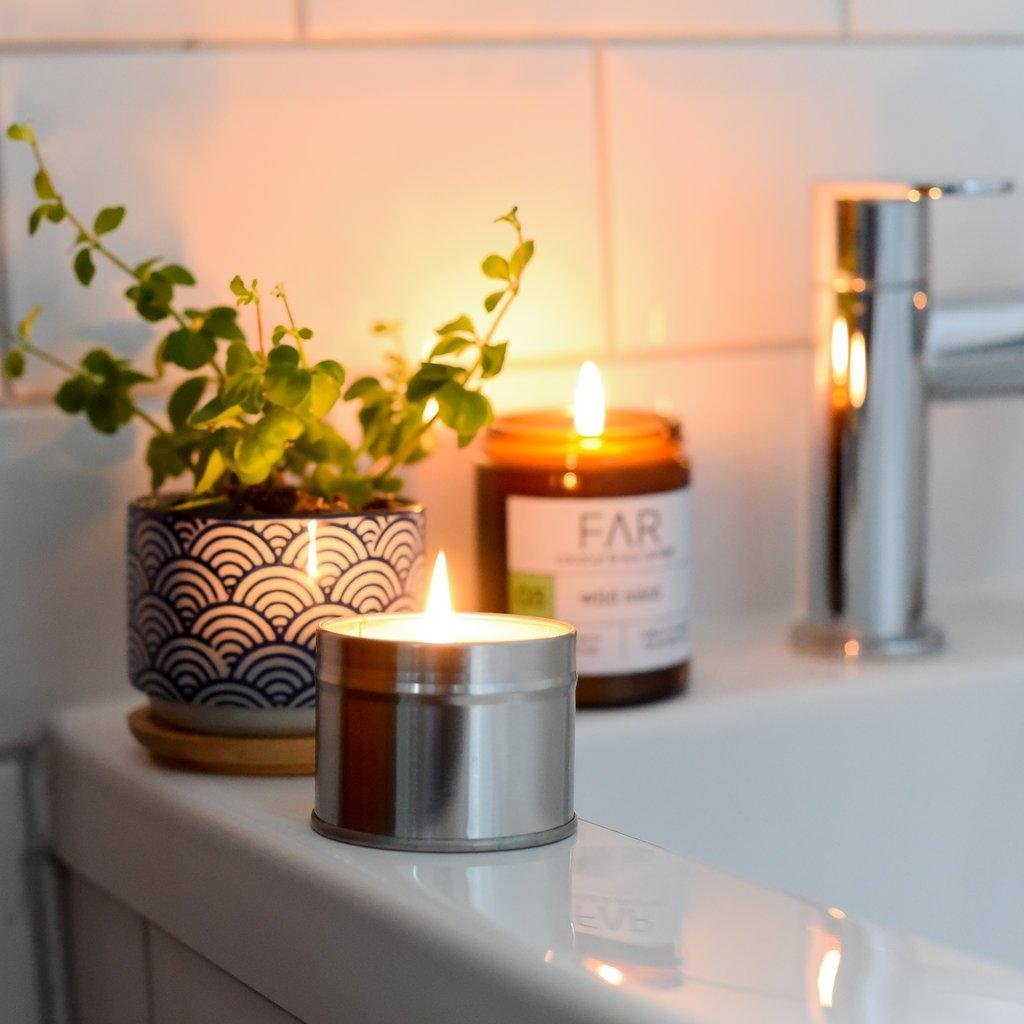
Discover the Best Brown Glass Jars for Candles: Enhance Your Home Decor with Style
You can find the best brown glass jars with quality scented candles at FAR Candles. a versatile choice for your home decoration

The burn time of an amber glass candle is the length of time it can continuously light up before it’s all gone. This average duration depends on a few things like the size of the candle, the wax type, and even how long the wick is. For instance, larger candles and those made with special types of wax usually last a lot longer than smaller ones or those with regular wax. Surprise twist? Well, a 16 oz amber glass candle can give you a nice soft glow and relaxing scent for around 90 hours. And now, speaking of sizes…
Contents
ToggleThe average burn time of an 8oz soy wax candle housed in an amber glass container is approximately 30+ hours. Factors such as wax type, fragrance load, wick size, and burning conditions can influence burn duration, but our premium soy wax blend candles in this vessel typically provide a 30+ hour burn time.
Types of Amber Glass Candles
Amber glass candles provide a wide array of options to cater to different preferences and needs. They are available in various sizes, ranging from 4oz to 16oz, offering versatility to illuminate different spaces and meet individual scent intensity preferences. Each size has its unique advantages, providing distinct burn times and fragrance experiences.
When selecting an amber glass candle, it’s crucial to consider the specific ambiance you want to create and the duration for which you intend to enjoy the fragrance. Smaller 4oz candles may be ideal for intimate spaces or decorative arrangements, while larger 16oz options could be preferred for open areas or extended use.
Moreover, these candles come in an assortment of scents, ranging from floral and fruity to woody and spicy notes. The choice of scent can significantly impact the overall room ambiance, making it important to select a fragrance that aligns with your preferences and complements the surrounding environment.
The burn times of these candles vary based on factors such as wax type, fragrance concentration, and wick composition. These variations make it essential for consumers to examine product details and consider their specific burning time requirements before making a purchase.
For instance, a 4oz amber glass candle might be perfect for creating an inviting atmosphere in a small bedroom while having an average burn time of around 15-20 hours. On the other hand, an 8oz candle could be better suited for a larger living space and provide a longer burn time averaging between 30-40 hours.
Combining multiple sizes and scents allows individuals to curate diverse sensory experiences throughout their living spaces. This variety gives consumers the flexibility to adapt the ambiance according to different moods and occasions.
In conclusion, the availability of diverse sizes and scents offers consumers the opportunity to personalise their olfactory experiences and create inviting atmospheres tailored to their specific preferences and spatial requirements. It is essential for buyers to consider these varying aspects when selecting amber glass candles to ensure they align with their desired ambiance and burn time needs.
Diving into the intricacies of understanding the burn time of an amber glass candle provides us with valuable insight into maximising its usage according to specific preferences and requirements. Let’s delve into this detailed exploration.
The burn time of a candle can vary widely, influenced by a multitude of factors such as wax type, candle size, wick length, and even the design of the candle itself. With amber glass candles, understanding their average burn time is crucial for both consumers and manufacturers alike. A longer burn time not only signifies the efficient use of wax but also indicates a well-designed candle with even combustion.
Firstly, the type of wax used plays a key role in determining the average burn time of an amber glass candle. Soy wax candles, for instance, are known for their longer burn times compared to paraffin wax candles due to their slower burning nature. The composition and quality of the wax directly affect how long the candle will last before it is fully consumed.
Additionally, the size of the candle and the length of the wick significantly impact its burn time. An 8 oz amber glass candle with a single wick would generally have an average burn time ranging from 40-50 hours, while a larger 16 oz amber glass candle with a double wick could potentially last anywhere between 60-70 hours. These variations emphasise the importance of considering both candle size and wick configuration when estimating burn times.
Imagine a scenario where you place two candles side by side, both made of soy wax and housed in amber glass containers. One is significantly larger than the other and boasts a double-wick design. Logically, one would expect the larger candle with two wicks to have a longer burn time compared to its smaller counterpart due to the increased wax volume and improved heat distribution.
Understanding these nuanced details about amber glass candle burn times can help consumers make informed decisions regarding their purchases based on their individual needs and preferences, while also aiding manufacturers in designing more efficient and longer-lasting products.
Now that we’ve grasped the factors influencing the average burn time of amber glass candles, let’s delve into the major determinants affecting this crucial aspect of candle performance.
Candle burn time can vary significantly depending on multiple factors, from the type of wax used to the size of the candle itself. Understanding these factors can help you make informed decisions when choosing candles for your space.
The type of wax used in a candle is a key determinant of its burn time. For example, soy wax generally burns longer than paraffin wax because soy wax has a lower melting point, allowing it to create a larger wax pool around the wick, resulting in slower and more efficient burning. Beeswax, another popular option, also tends to offer a longer burn time compared to paraffin wax.
Another critical factor affecting burn time is the size and type of the wick. A larger wick typically results in faster burning, while a smaller wick might extend the life of the candle. Wood wicks are particularly interesting as they tend to provide a slow and steady flame, which can contribute to longer burn times compared to traditional cotton wicks.
In fact, wood wicks from certain manufacturers have been known to extend the burn time of candles to around 80-100 hours when burned correctly.
Unsurprisingly, the sheer size of a candle plays a significant role in determining its burn time. Larger candles generally contain more wax and thus burn for a longer duration compared to smaller ones. While an 8oz candle might last around 40-50 hours, larger 16oz candles could potentially burn for approximately 60 hours. However, it’s important to note that this is just an estimate, and various other factors can influence actual burn times.
Variable | Impact On Burn Time |
Wax Type: | Soy wax – 40 – 50 hours, Paraffin wax – 35 – 40 hours |
Wick: | Small wick – 25 – 30 hours, Large wick – 50 – 60 hours |
Candle Size: | 8 oz container – 35 – 40 hours, 12 oz container – 50 – 55 hours |
Considering these factors can guide your choice when selecting candles. It’s important to recognise that numerous variables contribute to the overall burn time, making it essential to consider all relevant aspects when determining how long a candle will last under specific burning conditions.
By understanding these factors, you’ll be better equipped to choose candles that not only suit your preferences but also meet your desired burn time expectations.
Now equipped with an understanding of the key elements affecting candle burn time, let’s explore how atmospheric conditions play into this crucial aspect of candle usage.
The environment in which a candle burns plays a significant role in determining its burn time. Atmospheric factors such as airflow and humidity can directly influence the burning process and the overall longevity of a candle.
Consider the impact of airflow on candle burn time. An open window or air currents can disrupt the steady and even burning of a candle. The influx of air caused by a drought can lead to the formation of an uneven melt pool, resulting in tunnelling and ultimately shortening the overall burn time. The disturbance caused by uneven airflow can also cause fluctuations in the flame’s size and intensity, affecting the rate at which the wax is consumed. Therefore, it is essential to place candles away from draughty areas to ensure a consistent and prolonged burn time.
Additionally, if you notice that a candle is burning unevenly due to drafts, consider using a jar or cloth to shield it from direct air currents.
Humidity levels also play a critical role in influencing the combustion of a candle. High humidity can impede the proper combustion process of the candle, affecting its consistency and burn time. When exposed to high humidity environments, candles may exhibit diminished performance, leading to shorter burn times and potential issues with dripping or sputtering flames.
For optimal performance, it is advisable to store candles in low humidity environments. By doing so, you can help preserve the integrity of the candle wax and ensure a more consistent and extended burn time for each candle.
Understanding how airflow and humidity affect candle burn time sheds light on the importance of selecting suitable environments for burning and storing candles. As we delve deeper into these influential factors, we gain valuable insights on optimising the burning experience and maximising the longevity of our cherished candles.
When it comes to selecting candles, it’s more than just choosing a scent or a pretty design. The quality of the wax and wick makes a significant difference in how long the candle will last and how well it burns.
High-Quality Wax The type of wax used in a candle affects its burn time. Soy wax, for example, is known for its clean and slow burn, making it one of the best choices for longer burn times. In addition to the type of wax, the quality of the wax also matters. Low-quality or impure wax can contain additives or contaminants that affect its burning characteristics. When you choose candles from reputable sellers like farcandles.com, you can be confident that you’re getting high-grade, pure soy wax that contributes to longer and cleaner burn times.
Wick Quality Now let’s talk about the wick. The wick is like the engine of the candle – it’s what keeps the flame going. Cotton wicks are commonly used for longer burn times and cleaner combustion, as they don’t produce as much soot as other materials. The thickness of the wick also plays a role; thicker wicks tend to offer a longer burn time due to their ability to draw more wax up into the flame.
For instance, a candle from farcandles.com uses cotton wicks that are carefully selected for each specific candle type. This attention to detail ensures that the candles burn optimally, providing customers with an extended burning experience that resonates with the high-quality standards of the brand.
In summary, when choosing candles, checking the type of wax and wick used is crucial. Opting for high-quality materials from trusted sellers like farncandles.com not only guarantees longer and cleaner burn times but also ensures a worthwhile investment in creating a warm and inviting ambiance in your space.
Armed with an understanding of optimal wax and wick quality in candles, let’s now turn our attention to practical tips that can help prolong the burn time of your favourite candles.
Candles not only add warmth and closeness to a space but can also create a relaxing and inviting atmosphere. However, it’s essential to know how to properly care for them to ensure you get the most out of each candle. By exercising a few good habits, you can enhance the longevity of your candles, saving money and enjoying their lovely scents for longer.
Trimming the wick before each use may seem like a small task, but it plays a large role in promoting a slower and more even burn. When the wick is too long, it can create larger flames, causing the wax to melt faster than intended. This not only shortens the life of the candle but can also lead to soot buildup on the container and an uneven burn pool.
Removing any debris or wick trimmings from the wax isn’t just about keeping things tidy; it’s crucial for preventing uneven burning and extending the candle’s lifespan. Wick trimmings that are left sitting in the melted wax can affect how the candle burns; they can introduce air pockets in the melt pool and draw carbon particles into the flame, leading to a decrease in scent throw and overall performance. To clean your candle after use, scoop out any offending pieces using a paper towel or cotton swab.
It’s tempting to let your favourite candle burn for hours on end, especially when you’re savouring its aroma during long, cosy evenings. However, keeping a candle lit for excessively long periods can deplete the wax faster. Excessive burning can also cause the fragrance to “burn off” more quickly than intended, resulting in a less potent scent over time. Therefore, it’s recommended to limit each burn to 3-4 hours maximum. This not only helps maximise the candle’s longevity but also ensures consistent fragrance experience with each use.
Applying these simple yet effective tips will help you get more out of your candles while maintaining an optimal burning experience. Take a look at our scented candles with an amber jar.

You can find the best brown glass jars with quality scented candles at FAR Candles. a versatile choice for your home decoration

Knowing how to clean and maintain your amber glass candles doesn’t have to be tricky. Simple steps can significantly extend their lifespan
